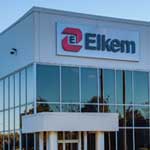With 26% of its sales by the silicones division generated from new products launched in past five years, Norwegian silicones provider Elkem is planning a flagship NOK150-million research and innovation centre in Shanghai. Furthermore, the silicones Xinghuo expansion project in China is expected to generate additional NOK5 billion of sales from downstream specialisation by 2030
To reach this target, the new R&I centre will house several application centres addressing the development trends in key industries such as high-performance silicone products for EVs, medical devices, cosmetics, coating materials for textile, leather and airbags, and products for 3D printing.
Meanwhile, Elkem reported stellar quarterly results, especially driven by strong performance in the Silicon Products and Carbon Solutions division, despite what it says are challenges arising from high energy, raw material and transportation costs. Elkem also sees a strong outlook for the second quarter 2022.
Its total operating income for the first quarter 2022 was NOK11.8 billion, which was all-time high and up 65% from the corresponding quarter last year. Earnings before interest, taxes, depreciation and amortisation (EBITDA) amounted to NOK3.8 billion in the quarter, compared to NOK1.2 billion in the first quarter 2021.
“Elkem is starting 2022 at an all-time high, delivering our third consecutive quarter of record results, after a record year in 2021. Our first quarter earnings have been more than tripled from the same period last year. Elkem sees strong demand going into the second quarter, explained by strong market positions, and robust integrated value chains. We also continue to position Elkem for the future in line with our strategy, having achieved a rating among the top 1% of companies on sustainability, investing in specialisation and innovation with a new R&I centre in Shanghai and announcing the partnership with Hydro and Altor to accelerate the growth of Vianode as a producer of sustainable battery materials,” says Helge Aasen, Elkem’s CEO.
Elkem has benefitted from high prices and good demand in key markets. The energy crisis in Europe has led to capacity curtailments among silicon and ferrosilicon producers. This has resulted in tight market conditions. In addition, the industry has been impacted by raw material constraints and transportation problems, resulting in general cost pressure and higher sales prices. Elkem says its integrated business model has ensured good access to critical raw materials and relatively stable costs.
In April 2022, Elkem announced a partnership with Hydro and Altor to accelerate the growth of Vianode, a producer of sustainable battery materials. Hydro and Altor will each have 30% ownership in Vianode, while Elkem will retain 40% ownership. The transaction is subject to formal and regulatory approvals. Vianode has developed a range of synthetic graphite products for batteries with unique performance characteristics and produced with significantly lower CO2 emissions than today’s standard materials. An investment decision for a potential first-phase plant at Herøya, Norway, is expected in the first half of 2022. This investment is estimated to around NOK2 billion and is pending clarifications related to framework conditions.
As the Russian invasion of Ukraine continues, Elkem says it does not have any plants or own employees in Ukraine or Russia, and the sales to these countries constituted “very limited parts” of its revenues in 2021.
Elkem continues to see strong demand going into the second quarter, explained by strong market positions, and robust and integrated value chains.
In Silicones, Elkem’s operations in EMEA and US will gradually benefit from somewhat lower silicon prices.
However, in Asia, Covid restrictions in China could impact demand.
Silicon Products will however continue to benefit from strong demand and high prices. The contract prices for silicon will be somewhat down compared to the first quarter 2022, but remaining at “high attractive levels”, it adds.
Carbon Solutions continues to benefit from strong steel and ferroalloys markets outside China but could be exposed to raw material and transportation constraints.

